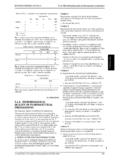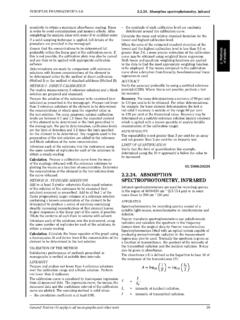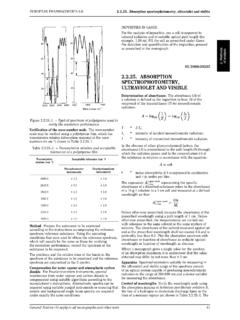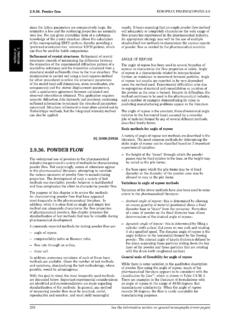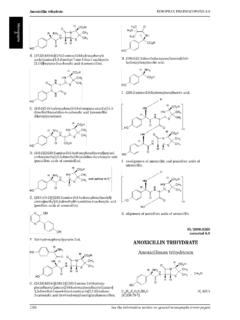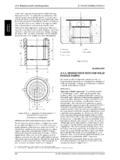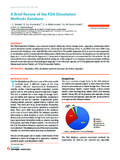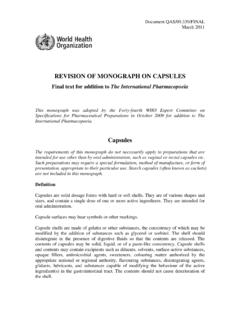Transcription of EUROPEAN PHARMACOPOEIA 5 - uspbpep.com
1 EUROPEAN PHARMACOPOEIA Disintegration of tablets and capsules PHARMACEUTICAL TEST A - TABLETS AND CAPSULES OF NORMAL SIZE. TECHNICAL PROCEDURES Apparatus. The main part of the apparatus (Figure ). is a rigid basket-rack assembly supporting 6 cylindrical 01/2005:20901 transparent tubes mm long, mm in internal diameter, and with a wall thickness of about 2 mm. Each DISINTEGRATION OF TABLETS tube is provided with a cylindrical disc mm in AND CAPSULES diameter and mm thick, made of transparent plastic with a relative density of to or weighing The disintegration test determines whether tablets or g. Each disc is pierced by 5 holes 2 mm in diameter, capsules disintegrate within the prescribed time when placed 1 in the centre and the other 4 spaced equally on a circle in a liquid medium in the experimental conditions prescribed of radius 6 mm from the centre of the disc. On the lateral below. surface of the disc, 4 equally spaced grooves are cut in such Disintegration is considered to be achieved when : a way that at the upper surface of the disc they are mm a) no residue remains on the screen, or wide and mm deep and at the lower surface mm square.
2 The tubes are held vertically by 2 separate and b) if there is a residue, it consists of a soft mass having no superimposed rigid plastic plates 90 mm in diameter and palpably firm, unmoistened core, or 6 mm thick with 6 holes. The holes are equidistant from the c) only fragments of coating (tablets) or only fragments of centre of the plate and equally spaced. Attached to the under shell (capsules) remain on the screen ; if a disc has been side of the lower plate is a piece of woven gauze made from used (capsules), fragments of shell may adhere to the lower stainless steel wire mm in diameter and having mesh surface of the disc. apertures of mm. The plates are held rigidly in position Use apparatus A for tablets and capsules that are not and mm apart by vertical metal rods at the periphery, greater than 18 mm long. For larger tablets or capsules use a metal rod is also fixed to the centre of the upper plate to apparatus B. enable the assembly to be attached to a mechanical device Figure Apparatus A.
3 Dimensions in millimetres General Notices (1) apply to all monographs and other texts 225. Disintegration of tablets and capsules EUROPEAN PHARMACOPOEIA capable of raising and lowering it smoothly at a constant TEST B LARGE TABLETS AND LARGE CAPSULES. frequency between 29 and 32 cycles per minute, through a distance of 50 mm to 60 mm. Apparatus. The main part of the apparatus (Figure ). is a rigid basket-rack assembly supporting 3 cylindrical The assembly is suspended in the specified liquid in a transparent tubes mm long, mm mm in suitable vessel, preferably a 1 litre beaker. The volume of internal diameter, and with a wall thickness of mm. the liquid is such that when the assembly is in the highest Each tube is provided with a cylindrical disc mm position the wire mesh is at least 15 mm below the surface in diameter and mm thick, made of transparent of the liquid, and when the assembly is in the lowest position plastic with a relative density of to or weighing the wire mesh is at least 25 mm above the bottom of the g.
4 Each disc is pierced by 7 holes, each beaker and the upper open ends of the tubes remain above mm in diameter, 1 in the centre and the other the surface of the liquid. A suitable device maintains the 6 spaced equally on a circle of radius mm from the centre temperature of the liquid at 35-39 C. of the disc. The tubes are held vertically by 2 separate and The design of the basket-rack assembly may be varied superimposed rigid plastic plates 97 mm in diameter and provided the specifications for the tubes and wire mesh are 9 mm thick, with 3 holes. The holes are equidistant from maintained. the centre of the plate and equally spaced. Attached to Method. In each of the 6 tubes, place one tablet or capsule the under side of the lower plate is a piece of woven gauze and, if prescribed, add a disc ; suspend the assembly in made from stainless steel wire mm in diameter the beaker containing the specified liquid. Operate the and having mesh apertures of mm. The plates are apparatus for the prescribed period, withdraw the assembly held rigidly in position and mm apart by vertical metal and examine the state of the tablets or capsules.
5 To pass the rods at the periphery, a metal rod is also fixed to the centre test, all the tablets or capsules must have disintegrated. of the upper plate to enable the assembly to be attached Figure Apparatus B. Dimensions in millimetres 226 See the information section on general monographs (cover pages). EUROPEAN PHARMACOPOEIA Disintegration of suppositories and pessaries to a mechanical device capable of raising and lowering it maintained at 36-37 C, unless otherwise prescribed. The smoothly at constant frequency between 29 and 32 cycles apparatuses may also be placed together in a vessel with a per minute, through a distance of 55 2 mm. capacity of at least 12 litres. The beaker is fitted with a slow The assembly is suspended in the specified liquid medium in stirrer and a device that will hold the cylinders vertically not a suitable vessel, preferably a 1 litre beaker. The volume of less than 90 mm below the surface of the water and allow the liquid is such that when the assembly is in the highest them to be inverted without emerging from the water.
6 Position the wire mesh is at least 15 mm below the surface Method. Use three suppositories or pessaries. Place each of the liquid, and when the assembly is in the lowest position one on the lower disc of a device, place the latter in the sleeve the wire mesh is at least 25 mm above the bottom of the and secure. Invert the apparatuses every 10 min. Examine beaker and the upper open ends of the tubes remain above the samples after the period prescribed in the monograph. the surface of the liquid. A suitable device maintains the To pass the test all the samples must have disintegrated. temperature of the liquid at 35-39 C. The design of the basket-rack assembly may be varied provided the specifications for the tubes and wire mesh are maintained. Method. Test 6 tablets or capsules either by using 2 basket-rack assemblies in parallel or by repeating the procedure. In each of the 3 tubes, place one tablet or capsule and, if prescribed, add a disc ; suspend the assembly in the beaker containing the specified liquid.
7 Operate the apparatus for the prescribed period, withdraw the assembly and examine the state of the tablets or capsules. To pass the test, all 6 of the tablets or capsules must have disintegrated. 01/2005:20902. DISINTEGRATION OF. suppositories AND PESSARIES. The disintegration test determines whether the suppositories or pessaries soften or disintegrate within the prescribed time when placed in a liquid medium in the experimental conditions described below. Disintegration is considered to be achieved when : a) dissolution is complete, b) the components of the suppository or pessary have separated : melted fatty substances collect on the surface of the liquid, insoluble powders fall to the bottom and soluble components dissolve, depending on the type of preparation, the components may be distributed in one or more of these ways, c) there is softening of the sample that may be accompanied by appreciable change of shape without complete separation of the components, the softening is such that the suppository or pessary no longer has a solid core offering resistance to pressure of a glass rod, Figure Apparatus for disintegration of d) rupture of the gelatin shell of rectal or vaginal capsules suppositories and pessaries occurs allowing release of the contents, e) no residue remains on the perforated disc or if a residue Dimensions in millimetres remains, it consists only of a soft or frothy mass having no solid core offering resistance to pressure of a glass rod METHOD OF OPERATION FOR VAGINAL TABLETS.
8 (vaginal tablets). Use the apparatus described above, arranged so as to rest Apparatus. The apparatus (Figure ) consists of a on the hooks (see Figure ). Place it in a beaker of sleeve of glass or suitable transparent plastic, of appropriate suitable diameter containing water maintained at 36-37 C. thickness, to the interior of which is attached by means of with the level just below the upper perforated disc. Using three hooks a metal device consisting of two perforated a pipette, adjust the level with water at 36-37 C until a stainless metal discs each containing 39 holes 4 mm in uniform film covers the perforations of the disc. Use three diameter ; the diameter of the discs is similar to that of the vaginal tablets. Place each one on the upper plate of an interior of the sleeve ; the discs are about 30 mm apart. apparatus and cover the latter with a glass plate to maintain The test is carried out using three such apparatuses each appropriate conditions of humidity.
9 Examine the state of the containing a single sample. Each apparatus is placed in a samples after the period prescribed in the monograph. To beaker with a capacity of at least 4 litres filled with water pass the test all the samples must have disintegrated. General Notices (1) apply to all monographs and other texts 227.
